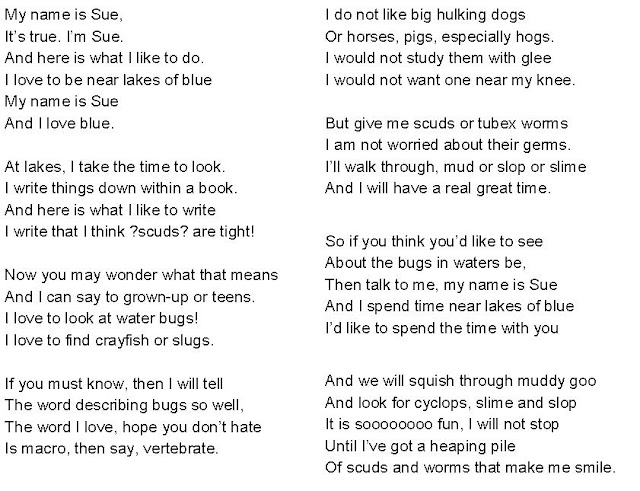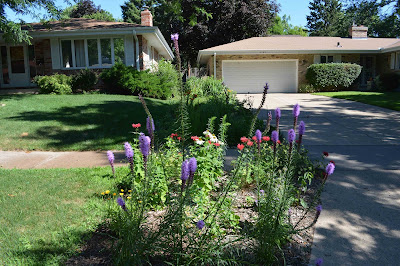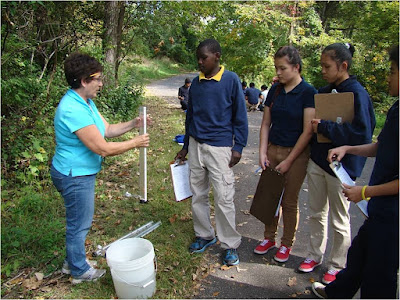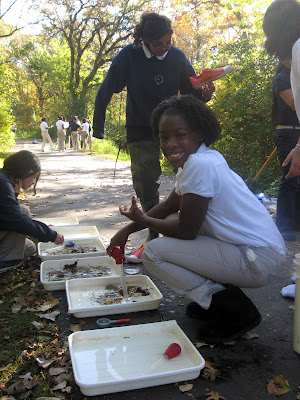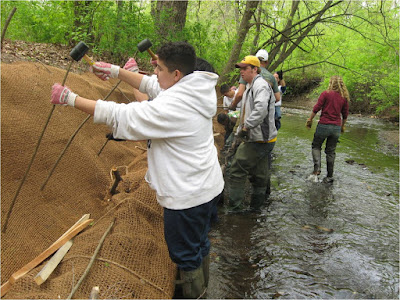
Sue Fourniea: Champion for Young People and Water
by Randee Edmundson and Sage Passi
 |
| Sue Fourniea, St. Paul science teacher, along with Ames Lake colleagues, receive a Watershed Excellence Award for their years of engaging young people in watershed education and protection. |
“We decided to do something that would bring our students together, using the geographical community we had in common to learn about the natural environment and the relationship humans have with their natural and neighborhood communities. As we conjured up these ideas of partnering, Jeff said, “and we have a great science teacher who is gonna love this! Her name is Sue Fourniea.” – Randee Edmundson
 |
| Sue Fourniea out on the trail at Ames Lake with former Cleveland special education technology teacher Pam Bloedoorn. |
These words shared by Randee Edmundson, science educator and RWMWD Citizen Advisory Commission member, were the beginning of an eight-year, cross-school environmental stewardship of Ames Lake watershed started by Sue, Randee and Jeff Theune, an eighth grade social studies teacher at Cleveland Quality Middle School in 1997. This accolade about Sue, was echoed by Randee Edmundson, who coordinated a “spoken word” performance and slide show with Ames Lake team colleagues during the Watershed District Excellence Awards ceremony last November to honor Sue for her many years of watershed service, collaboration and involvement with St. Paul youth in water and environmental related causes.
 |
| Sue gears up for a canoe trip starting at Lake Gervais. Jerry Webster, a former Audubon volunteer, accompanied them. |
Interdisciplinary Teams Partner with Mounds Park Academy
As a science teacher at Cleveland Middle School for seventeen years, Sue was part of an interdisciplinary team of teachers and students that came together multiple times a year to study and do service learning activities; first about rivers and then about Ames Lake and Phalen Lake on the East Side of St. Paul. In the early years this school teamed up with a private school, Mounds Park Academy, to engage young people in learning about local watershed issues.
 |
| Sue looks on as her students plant a tree on the edge of the site of Phalen Shopping Center before the center was torn down for the Ames Lake Restoration in 2000. |
“Sue and I as science teachers wanted the students to come together in small, cross-school teams and do real science investigations that mattered in the community in which they lived. For Jeff, as a social studies teacher, and his wife Regina, a dramatic artist, it meant an opportunity to connect responsibly as citizens to the river we depend on, and to use the arts as a way to develop meaningful, functional relationships between strangers and with people you have preconceptions about in regard to socio-economic status, race, religion, gender or age. These preconceptions, they believed, get in the way of listening and solving mutual problems – maintaining a healthy environment on which all of us depend for survival.” – Randee Edmundson describing their partnership
 |
| Cleveland students display the grocery carts they rescued from the bottom of Ames Lake. |
Students Research Ames Lake Ecology and Water Quality
Each year, this hand-selected group of seventh and eighth grade teams collected water samples at Ames Lake, Phalen Lake and the Phalen Wetland and compared their results. Sue and Randee led the Ecology and Water Quality teams respectively. Students did bio-monitoring, studied the restored wetland’s ecology and brought back macroinvertebrates to identify and classify in order to determine the water quality of their local water bodies. They shot photos cataloguing the native plants, created displays and kept records of their data for many years.
“Sue is the kind of lady to keep you on your toes. I wanted to learn from her since I heard of her when I was in the seventh grade. She was academically tough for a reason and preparing us for college. She expected nothing less. A proud physical feature of her was her height which was measurable to many of her Hmong students. Sue Fourniea was why her students focused on academics, because she cared. Outspoken, committed and brilliant – she is part of the foundation to my fortress.” – A quote from one of Sue’s students
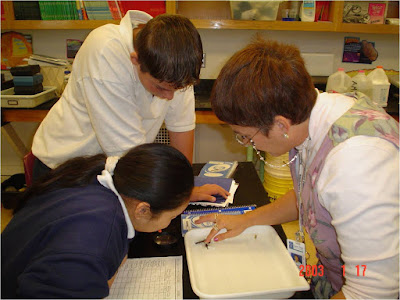 |
| Sue helps her science students identify macroinvertebrates. |
“The Ames Lake project has allowed me to teach the way that works best for me and for our students. Our students need self-confidence, a reason to be in school, to resolve differences and negotiate with all people. They feel that they have a hand in making an impact on helping their neighborhood environment become a better place.” – Sue Fourniea
A Shopping Center Transformed Back to Ames Lake
 |
| Cleveland students plant prairie plugs in the upland area around Ames Lake in 2000. |
 |
| The ecology team studied the diverse plants in the Ames Lake restoration for many years. |
Sue could be academically challenging, but she also used her sense of humor to engage students in learning. Here’s a poem she wrote about herself in order to share some vocabulary words about the macroinvertebrates that live in Ames Lake.
T
Getting to Know the Neighborhood
The Ames Lake teams did a yearly round robin tour, interviewing and getting acquainted with community leaders in the east St. Paul neighborhood including district council representatives, community organizers, city staff and elders who lived in a high rise apartment complex across from Ames Lake.
The Influencing Public Policy for Sustainability teams led outreach and educational and arts activities in the community. All Cleveland student teams also participated in the restoration of the wetland and prairie habitats around Ames Lake in 2000.
 |
| Karen Swenson, Eastside Neighborhood Development Corporation, explains why the neighborhood decided to tear down the Phalen Shopping Center and restore Ames Lake. |
 |
| Chuck Repke, Executive Director of District 2 Community Council, brainstorms with Cleveland students. |
Aloun Phoulavan , Cleveland art teacher reflected on their collaboration.
“I remember the trash piles! Oh, the things we used to find. Thanks, Sue, for adding garbage collector and conservationist to all of our resumes. Sue was really driven and had such vision. Every time I have the opportunity to drive or bike by Ames Lake I think of her determination and I hope the students who participated still feel pride in the beauty of what they all accomplished.”
 |
| Sue Fourniea and students from her water quality team display their trash collected at Ames Lake. |
A Symbol Emerges
 |
| Alloun’s students preparing the mold of the heron sculpture casted by local artists. This project reflected the creative teamwork of artists and the community. |
Cleveland art teacher Alloun Poulavan led the Art and Design teams. These students worked with the community to create a sculpture at Ames Lake that would reflect both nature and the neighborhood. After three years of prototypes, fundraising and negotiations, all stakeholders agreed on one of the student prototypes. A brass heron sculpture is installed by the shore of Ames Lake near Phalen Boulevard with this stone inscription.
This Great Blue Heron sculpture, created by students at Cleveland Junior High School, is our gift to Ames Lake Neighborhood. May it inspire environmental consciousness in the community, a sense of ownership and appreciation of our wetlands.
After the brass heron was complete, students held a community dedication ceremony and installed the sculpture on the edge of the Ames Lake wetland.
“$500,000 to Realize Our Dreams”
During the recognition dinner, Randee recalled the next phase of the project Sue was advocating,
The next three years we had $500,000 to realize the dreams we imagined – multiple partners including dramatic artist specialist, technology specialist, Harding High School, Cleveland Quality Middle School who would do the Ames Lake Project by designing actions and projects to address neighborhood needs. Then we would add another grade level to the process at B. C. Elementary to raise the younger students to learn the foundation of ecology and living systems at Belwin. Each year the new students built on what was learned and created by the students the year before.
“In the fourth year of the All-Ames Lake Partnership, Sue came to me and said ‘We’ve got to write this Federal Environmental Magnet grant proposal offered through SPPS.’ Together we got our teachers and principals to generate their parts needed and we submitted a proposal. The next three years we had $500,000 to realize the dreams we imagined – multiple partners including a dramatic artist specialist, a technology specialist, Harding High School, and Cleveland Quality Middle School who would do the Ames Lake Project by designing actions and projects to address neighborhood needs and adding another grade level to the process at Battle Creek Elementary, to raise the younger students to learn the foundation of ecology and living systems at Belwin. Each year the new students built on what was learned and created by the students the year before. ” – Randee Edmundson
 |
| Jill Danner |
Jill Danner, RWMWD Citizen Advisory Commission member and retired teaching assistant at Harding High School, recounted one of her fond memories of the project during the Recognition Dinner. She credits Sue’s creativity and fun-loving personality in making the Ames Lake project successful.
“Sue was always willing to support whatever crazy idea Randee, Steve and I came up with. Sending teams made up of one high school student, one middle school student and one elementary student into the woods in February to start a fire sounded like a great idea. It was so fun we did it two years. Sue has been a great supporter. She is fun to be around.” – Jill Danner
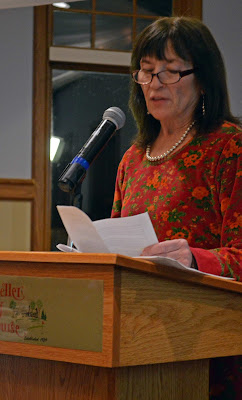 |
| Liz McCambridge |
“Sue was my Rock”
Liz McCambridge, social studies teacher at Cleveland Quality Middle School, led the Influencing Public Policy for Sustainability Ames Lake Teams.
Liz shared her thoughts,
“I have had the most rewarding, inspiring, fun years in my twenty years of teaching and being a team leader in the Ames Lake Project. The students have been motivated, awesome learners who have taught me more than I have taught them. And you, Sue, were the glue that held it all together. You were my rock. By-the-way, we were asked what word comes to mind when we think of you and that would be “honorable.”
Dramatic Artist Jayy Dubb Joins the Team
When Randee became the coordinator for a new federal grant project, she asked for a recommendation for a dramatic artist from Jeff Theune’s wife Regina, an artist who had worked with Cleveland on the first phase of the Ames Lake Project.
Regina’s first recommendation was James Williams (Jayy Dubb) who has a life-long history of working with youth and was instrumental in using dramatic arts in order to change relationships between students, teachers, community partners and nature for the Ames Lake Project.
 |
| Sue’s water quality team dramatizes their experiences at Ames Lake collecting macroinvertebrates. |
Jayy Dubb used theater games to find common ground, be curious about the unknowns in a relationship and take greater risks. His work helped everyone, students and teachers, share productively in the work and to create dramatizations each year that reflected their relationships and experiences in the program. His inspirational words have culminated in the teams’ honoring storytelling.
 |
| Jayy Dubb coaches teams to help them reflect on their experiences. |
Jayy Dubb (aka James Williams) has a long professional history of working in theater. This history includes The Kennedy Center, Off Broadway and Chicago, The Guthrie, The Penumbra, Park Square, Pillsbury House and other theatres in the US and Tanzania. He has used theater arts with incarcerated youth to write, create and perform their own stories in Minneapolis through the Pillsbury House Theater community programs. He has also worked with Minneapolis Washburn High School and St. Paul Central High School Public School Theater.
Currently, James Williams is playing the part of Gloucester in King Lear at the Guthrie Theater through April 2, 2017. To learn more about Jayy and his theater collaboration, watch for a future article in the Ripple.
“Be alive to the new thing. To work out the next step. That’s the ultimate goal. Because then you understand there always is the next thing. That you’re never through learning. That you don’t know all the facts. You haven’t read all the books. You don’t know all the stories, because there is a next thing that happens. There is a new thing that can come if you’re present in the room, and you’re always challenging, and you’re looking for the new thing — the next thing automatically comes.” – Jayy Dubb’s advice to the Ames Lake Team
And, sure enough, the “new thing” came along for Sue Fourniea.
Accomplishments at Battle Creek Middle School
 |
| Sue’s science students marched in the WaterFest Parade at Lake Phalen. |
When Cleveland Middle School changed identity and became the upper campus of Farnsworth Aerospace, Sue and many of the teachers, moved on to other schools. Sue went to Battle Creek Middle School where she proved to be a powerhouse for Watershed District projects over the next eight years.
At Battle Creek, Sue’s classes helped prepare for a Watershed District creek erosion project by cutting large quantities of buckthorn which were used to create brush bundles and then installed on a stretch of the creek, along with other native plugs in order to slow erosion.
Here Battle Creek Middle School students trim buckthorn growing alongside the creek.
Sue supervised students trimming buckthorn that would be used to create brush bundles for an erosion project.
Simba Blood, RWMWD Natural Resources Technician, helped students assemble buckthorn bundles. Sue filmed the process.
Battle Creek students worked with the Watershed District to install plugs with the brush bundles they created.
This Wasn’t the Only Project her Students Tackled
Students recruited a neighborhood homeowner and worked with her to build a rain garden in her yard.
In later years, Sue’s classes partnered with other science classes to construct two more rain gardens with residents in the neighborhood. In the spring her students crossed the bridge over the creek, performed site assessments on the property, then returned to excavate, build berms (some with rock walls) and plant these intensive projects.
Her students also helped install shrubs and native grasses and forbs in front of the school.
Battle Creek students removed sod in a nearby residence in preparation for the construction of a rain garden.
These rain garden projects involved a lot of soil moving. Teamwork with many classes was necessary.
The final product was a rain garden that captured driveway runoff in order to protect Battle Creek’s water.
Each fall Sue brought her classes to Battle Creek to do stream monitoring.
For the past two years her classes have also done storm drain stenciling in the neighborhood.
Sue has a propensity for involving other science teachers and classes into projects and helping to grow the program at Battle Creek Middle School. The school is adjacent to Battle Creek and opportunities for engaging students continues to evolve.
Sue demonstrates the use of a Secchi Disk to measure Battle Creek’s water transparency.
Battle Creek eighth grade science students identify the macroinvertebrates that are
living in Battle Creek.
Sue involved other classrooms into the creek bank erosion project.
Here students pound in live willow and red osier dogwood stakes as a way to help stabilize the bank.
Sue’s Students Take on Global Issues
In addition to local efforts on water-based issues, during the 2011-2012 school year, Sue’s students took on a global issue by participating in Women and Water, a collaboration that culminated in a large-scale cultural event at the Regis Center for the Arts at the University of Minnesota along with multiple schools in the spring of 2012. Sue’s students worked with spoken-word poet and teaching artist, Tou Saiko Lee, to write and perform poems in response to serious issues about lack of clean water on a global level.
Amanda was a student at Cleveland Middle School and a member of the Influencing Public Policy for Sustainability Ames Lake Team. She presented her poem and was part of a student panel at the National Science Teachers Association Conference in 2003.
Amanda’s Poem
The neighborhood, that’s what’s important to me
And what I want to do is influence policy.
I have fun while I work, I work in my group
To keep the ‘hood clean, we work as a troop.
Community builds when you care for a place
You work with your friends and you work face to face…
There is happiness, love, there is friendship, and trust.
Yes, community builds and it’s worth any fuss.
Of course, there’s the water…it’s our life… understand!
It controls what we do, so saving it’s grand!
The adults who are here must know how much they need
To lead kids to the water, and then let the kids lead…
For kids do what’s right, when the way is made plain
They will care for the land, plants, water and grain.
You must care for the land, if you care for yourself
You must get out and work, not stay on a shelf.
For you are the future, and your work will show!
It will keep the land safe it will help all things grow…
Keep up all your effort, keep it up with your might!
When you fight for the land, you are doing what’s right!
